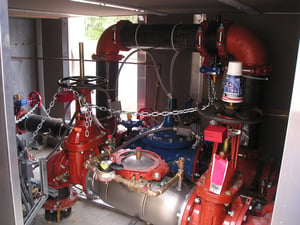If your backflow preventer isn’t performing as well as it should, you may be forced to make a difficult decision. Should you repair or replace it? There are several factors to consider. To help with this process we've outlined several tips and best practices for backflow preventer maintenance.
With proper maintenance and annual testing, backflow prevention assemblies can last for many years. But mechanical backflow prevention assemblies have internal seals, springs, and moving parts that are subject to clogging, wear or fatigue. And there will come a time when you must decide what’s more cost-effective: Repairing or replacing?
So, we asked Sean Cleary, vice president of the International Association of Plumbing and Mechanical Officials (IAPMO) and the Backflow Prevention Institute® (BPI) his thoughts. Cleary has been in the backflow business for over 40 years. He’s a licensed master plumber who’s worked in all phases of the cross-connection, plumbing, and mechanical industries. Let’s take a look at some of the factors he says you must consider when you’re deciding whether to repair or replace your backflow preventer.
Size of Your Backflow Preventer Valve
“One of the first things to consider is the size of your valve,” Cleary says. “A lot of times it’s simply easier (and more affordable) to replace a smaller valve that’s bad,” Cleary says. “I know of a few plumbing contractors who stock their service vans with a half-inch, three-quarter, and one-inch assemblies, and if they have a failure while they’re doing a test, it’s more economical for the customer to swap the valve out.”
Cleary also says it can be tough to get parts for an assembly, depending on your location. That too can factor into the decision of replacing a smaller valve rather than repairing it.
When it comes to a larger valve, Cleary says there are other things to consider. “The cost of replacing a larger valve is so much more than the cost of replacing a smaller assembly,” Cleary says. “You really have to look at the condition of the valve.”
Cleary says even if you can repair a larger valve, it may not mean that you should repair it. “You may have a 35-year-old valve with its epoxy coating flaking off, and even though it may only cost a few hundred dollars to repair, you may be better off installing a more modern valve that will be less expensive to maintain over the years.” Cleary says. “Today’s backflow preventers are shorter, they’re lighter, there are fewer parts and they’re easier to maintain.”
Condition of Your Valve
When you’re trying to decide if you should repair or replace, the condition of your backflow preventer is one of the biggest considerations. Cleary says if you have a smaller valve whose checks are brittle and ready to crack, you should consider replacing it. “If I have to replace two checks, along with the rest of the rubber parts and everything else, it may be less expensive to replace the valves.”
Another factor to consider with smaller valves is where it’s been installed. Take swimming pool equipment rooms, for instance. “The environment in these rooms may cause valve handles to rust away and affect the assembly body itself,” Cleary says.
In addition to the epoxy coating flaking off a larger valve, you should also consider the interior conditions of the valve — the valve make up. “If you have a larger valve with the epoxy coating coming off, the O ring won’t make the proper seal. There’s no way to fix the epoxy coating, and the water is going to start eating at the valve body itself,” Cleary says.
Cleary adds that you also have to pay attention to the shut-off valves on larger backflow preventers. If they’re not holding properly, you have to look at what’s going on internally. “If you have a 30-year-old valve that needs thousands of dollars in repairs, it’s probably time to replace it.”
The goal is to eliminate the risk of a cross-connection. Any temporary or permanent connection between a public water system or the customer's potable water system and any source or system containing nonpotable water or other substances can be devastating.
Location of Your Valve
Another thing that may factor into your decision to repair or replace is where your valve is located. Backflow preventers in an outdoor, above-ground enclosure are easier to work on. “More valves are going in enclosures, more valves are going above ground, and to be honest, that’s where they belong,” Cleary says.
A properly designed enclosure will have removable panels and a removable roof to make it much easier to test, repair or replace your backflow preventer. “Placing an approved backflow assembly in an outdoor enclosure makes it easier to keep up with annual testing and repairs because it’s more accessible,” Cleary says. Placing your backflow preventer in an enclosure also helps to minimize flood risks.
Ask the water jurisdiction to provide a standard detail for outdoor, above-ground backflow preventer installations. And for more information on enclosures, our “Guide to Industrial Enclosure Design” can help. It will provide an overview of the key design considerations including size and strength, climate control, access and maintenance.




